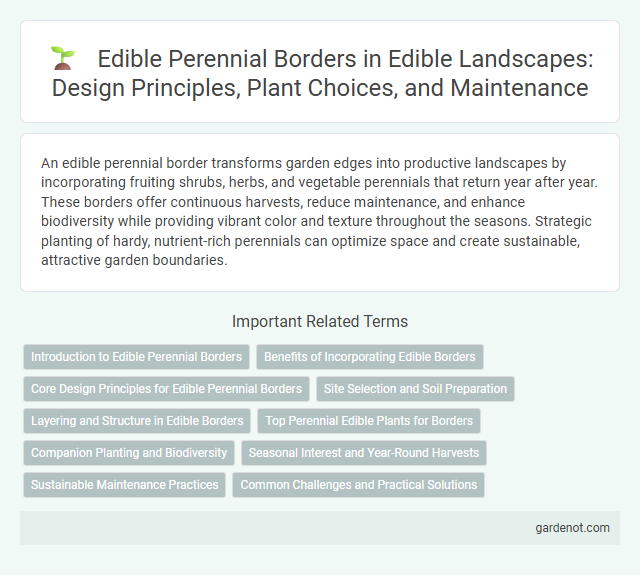An edible perennial border transforms garden edges into productive landscapes by incorporating fruiting shrubs, herbs, and vegetable perennials that return year after year. These borders offer continuous harvests, reduce maintenance, and enhance biodiversity while providing vibrant color and texture throughout the seasons. Strategic planting of hardy, nutrient-rich perennials can optimize space and create sustainable, attractive garden boundaries.
Introduction to Edible Perennial Borders
Edible perennial borders combine ornamental design with sustainable food production by integrating long-lasting edible plants such as herbs, berries, and perennial vegetables. These borders enhance garden aesthetics while providing seasonal harvests year after year without replanting. Incorporating plants like asparagus, rhubarb, and sage supports biodiversity and reduces maintenance compared to annual planting.
Benefits of Incorporating Edible Borders
Incorporating edible perennial borders enhances garden biodiversity by attracting pollinators and beneficial insects, promoting a healthier ecosystem. These borders provide a sustainable source of fresh, nutrient-rich fruits, vegetables, and herbs throughout multiple growing seasons, reducing reliance on store-bought produce. Edible borders also improve soil health through deep-rooted perennials that prevent erosion and increase organic matter, supporting long-term garden resilience.
Core Design Principles for Edible Perennial Borders
Edible perennial borders combine aesthetic appeal with productivity by integrating plants that provide year-round harvests while enhancing biodiversity. Key core design principles include selecting diverse species that complement each other's growth cycles, optimizing soil health through organic matter and proper moisture retention, and ensuring spatial arrangement supports sunlight access and air circulation. Incorporating native perennials helps reduce maintenance needs and fosters resilience against pests and diseases in sustainable edible landscapes.
Site Selection and Soil Preparation
Choosing a location with well-drained soil and ample sunlight is essential for establishing a thriving edible perennial border. Soil preparation should include testing pH levels to ensure a slightly acidic to neutral range (6.0-7.0) and enriching the soil with organic matter such as compost or well-rotted manure. Proper site selection combined with nutrient-rich, loose soil promotes robust root development and higher yields in perennial edible plants.
Layering and Structure in Edible Borders
Edible perennial borders thrive by incorporating strategic layering and structure, combining ground covers, mid-height vegetables, and taller fruit-bearing shrubs to maximize space and yield. Utilizing diverse plant heights and root depths enhances nutrient uptake and pest resistance, creating a resilient and productive foodscape. Careful arrangement ensures year-round harvest and visual appeal, integrating beneficial companion plants for optimal growth.
Top Perennial Edible Plants for Borders
Top perennial edible plants for borders include hardy herbs like rosemary, thyme, and sage, which provide year-round flavor and attractive foliage. Fruit-bearing perennials such as asparagus, rhubarb, and black currants add both aesthetic appeal and nutritious harvests. Incorporating these plants into edible borders enhances garden biodiversity while offering sustainable food sources.
Companion Planting and Biodiversity
An edible perennial border maximizes yield by utilizing companion planting techniques that enhance nutrient uptake and pest resistance among compatible species. Integrating diverse perennials such as herbs, fruits, and flowering plants fosters a balanced ecosystem, attracting beneficial insects and promoting soil health. This biodiversity-rich approach creates a sustainable, productive garden that supports pollinators and reduces the need for chemical interventions.
Seasonal Interest and Year-Round Harvests
Edible perennial borders combine diverse plant species to ensure continuous seasonal interest through varied foliage, flowers, and fruiting cycles. Incorporating plants like asparagus, rhubarb, and berry bushes provides year-round harvests, maximizing productivity in limited spaces. Strategic layering and succession planting optimize yields while enhancing garden aesthetics across all seasons.
Sustainable Maintenance Practices
Edible perennial borders require sustainable maintenance practices such as mulching to retain soil moisture and suppress weeds, reducing the need for chemical interventions. Incorporating nitrogen-fixing plants like clover enhances soil fertility naturally, supporting plant health over time. Regularly pruning and harvesting encourages vigorous growth while conserving resources and minimizing waste.
Common Challenges and Practical Solutions
Edible perennial borders often face challenges such as pest infestations, nutrient deficiencies, and competition from invasive plants. Implementing integrated pest management, using organic compost, and selecting compatible companion plants provide effective solutions to maintain plant health and productivity. Regular monitoring and soil testing further optimize growth conditions for sustainable edible landscapes.
Edible perennial border Infographic

 gardenot.com
gardenot.com